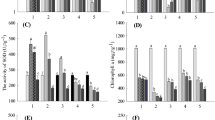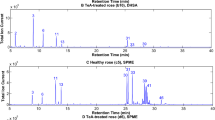Abstract
In the vicinity of big sagebrush (Artemisia tridentata), the growth of Nicotiana attenuata is negatively affected, in part due to the alleopathic effect of methyl jasmonate (MeJA) which is produced in large quantities by the aerial parts of sagebrush. Preliminary experiments suggested that growth-inhibiting substances were being emitted from the sagebrush roots. To identify the allelochemical secondary metabolites, we tested different root extracts in seedling growth bioassays with the naturally co-occurring native tobacco, Nicotiana attenuata, in a two-chamber Petri dish assay, optimized for tests of volatiles. Fractions rich in volatile compounds were particularly phytotoxic. We analyzed the volatiles emitted from the roots of intact Artemisia tridentata plants grown in soil, sand, and hydroponic cultures by using dynamic headspace extraction, headspace solvent-microextraction (HSME) and headspace solid-phase microextraction (HSPME), and GC-MS. Camphor, 1,8-cineol, nerol, and neryl isovalerate were phytotoxic and released as the major constituents. In addition to the phytotoxic monoterpenes, himachalenes, longifolene, caryophyllene, and acetylenic spiroethers, were found as characteristic components in the root’s volatiles. The allelopathic potential of these root volatiles was compared with that of methyl jasmonate (MeJA), one of the most active compounds emitted from above-ground parts of the plant.




Similar content being viewed by others
References
Adams, R. P. 2007. Identification of essential oil components by gas chromatography/mass spectrometry. Allured Pub. Co., Carol Stream, IL, USA.
Asplund, R. O. 1968. Monoterpenes: relationship between structure and inhibition of germination. Phytochemistry 7:1995–1997.
Bais, H. P., Weir, T. L., Perry, L. G., Gilroy, S., and Vivanco, J. M. 2006. The role of root exudates in rhizosphere interactions with plants and other organisms. Annu. Rev. Plant Biol. 57:233–266.
Baldwin, I. T. 1998. Jasmonate-induced responses are costly but benefit plants under attack in native populations. Proc. Natl. Acad. Sci. USA, 95:8113–8118.
Bertin, C., Yang, X., and Weston, L. A. 2003. The role of root exudates and allelochemicals in the rhizosphere. Plant Soil 256:67–83.
Bertin, C., Weston, L. A., Huang, T., Jander, G., Owens, T., Meinwald, J., and Schroeder, F. C. 2007. Grass roots chemistry: Meta-Tyrosine, an herbicidal nonprotein amino acid. Proc. Natl. Acad. Sci. USA, 104:16964–16969.
Blagojević, P., Radulović, N., Palić, R., and Stojanović, G. 2006. Chemical composition of the essential oils of Serbian wild-growing Artemisia absinthium and Artemisia vulgaris. J. Agric. Food Chem. 54:4780–4789.
Chen, F., Ro, D. K., Petri, J., Gershenzon, J., Bohlmann, J., Pichersky, E., and Tholl, D. 2004. Characterization of a root-specific arabidopsis terpene synthase responsible for the formation of the volatile monoterpene 1,8-cineole. Plant Physiol. 135:1956–1966.
Ens, E. J., and French, K. 2008. Exotic woody invader limits the recruitment of three indigenous plant species. Biol. Conservation 141:590–595.
Ens, E. J., Bremner, J. B., FRench, K., and Korth, J. 2009a. Identification of volatile compounds released by roots of an invasive plant, bitou bush (Chrysanthemoides monilifera spp. rotundata), and their inhibition of native seedling growth. Biol. Invasions 11:275–287.
Ens, E. J., French, K., Bremner, J. B., and Korth, J. 2009b. Novel technique shows different hydrophobic chemical signatures of exotic and indigenous plant soils with similar effects of extracts on indigenous species seedling growth. Plant Soil 326:403–414.
Epstein, W. W., Gaudioso, L. A., and Brewster, G. B. 1984. Essential oil constituents of Artemisia tridentata rothrockii. The isolation and characterization of two new irregular monoterpenes. J. Org. Chem. 49:2748–2754.
Field, B., Jordán, F., and Osbourn, A. 2006. First encounters—Deployment of defence-related natural products by plants. New Phytologist 172:193–207.
Flores, H. E., Vicanco, J. M., and Loyola-Vargas, V. M. 1999. ‘Radicle’ biochemistry: The biology of root-specific metabolism. Trends Plant Sci. 4:220–226.
Formacek, V., and Kubeczka, K.-H. 1982. Essential oils analysis by capillary gas chromatography and carbon-13 NMR spectroscopy. Wiley, New York.
Goel, D., Goel, R., Singh, V., Ali, M., Mallavarapu, G. R., and Kumar, S. 2007. Composition of the essential oil from the root of Artemisia annua. J. Nat. Med. 61:458–461.
Groves, C. R., and Anderson, J. E. 1981. Allelopathic effects of Artemisia tridentata leaves on germination and growth of two grass species. Am. Midl. Nat. 106:73–79
Gunawardena, K., Rivera, S. B., and Epstein, W. W. 2002. The monoterpenes of Artemisia tridentata ssp. vaseyana, Artemisia cana ssp. viscidula and Artemisia tridentata ssp. spiciformis. Phytochemistry 59:197–203.
Halligan, J. P. 1973. Bare areas associated with shrub stands in grassland: the case of Artemisia californica. BioScience 23:429–432.
Halligan, J. P. 1975. Toxic terpenes from Artemisia californica. Ecology 56:999–1003.
Hassner, A., and Alexanian, V. 1978. Direct room temperature esterification of carboxylic acids. Tetrahedron Lett. 46:4475–4478.
Hütsch, B. W., Augustin, J., and Merbach, W. 2002. Plant rhizodeposition—An important source for carbon turnover in soils. J. Plant Nutr. Soil Sci. 165:397–407.
Inderjit and Duke, S. O. 2003. Ecophysiological aspects of allelopathy. Planta 217:529–539.
Inderjit, and Nilsen, E. T. 2003. Bioassays and field studies for allelopathy in terrestrial plants: Progress and problems. Crit. Rev. Plant Sci. 22:221–238.
Karban, R., Baldwin, I. T., Baxter, K. J., Laue, G., and Felton, G. W. 2000. Communication between plants: Induced resistance in wild tobacco plants following clipping of neighboring sagebrush. Oecologia 125:66–71.
Karban, R., Maron, J., Felton, G. W., Ervin, G., and Eichenseer, H. 2003. Herbivore damage to sagebrush induces resistance in wild tobacco: Evidence for eavesdropping between plants. Oikos 100:325–332.
Karban, R., Shiojiri, K., Huntzinger, M., and Mccall, A. C. 2006. Damage-induced resistance in sagebrush: Volatiles are key to intra- and interplant communication. Ecology 87:922–930.
Kelsey, R. G., Wright, W. E., Sneva, F., Winward, A., and Britton, C. 1983. The concentration and composition of big sagebrush essential oils from Oregon. Biochem. Syst. Ecol. 11:353–360.
Kennedy, A. I., Deans, S. G., Svoboda, K. P., Gray, A. I., and Waterman, P. G. 1993. Volatile oils from normal and transformed root of Artemisia absinthium. Phytochemistry 32:1449–1451.
Kessler, A., Halitschke, R., Diezel, C., and Baldwin, I. T. 2006. Priming of plant defense responses in nature by airborne signaling between Artemisia tridentata and Nicotiana attenuata. Oecologia 148:280–292.
Kordali, S., Cakir, A., and Sutay, S. 2007. Inhibitory effects of monoterpenes on seed germination and seedling growth. Z. Naturforsch. C 62:207–214.
Krügel, T., Lim, M., Gase, K., Halitschke, R., and Baldwin, I. T. 2002. Agrobacterium-mediated transformation of Nicotiana attenuata, a model ecological expression system. Chemoecology 12:177–183.
Lin, C., Owen, S. M., and PeÑuelas, J. 2007. Volatile organic compounds in the roots and rhizosphere of Pinus spp. Soil Biol. Biochem. 39:951–960.
Martínez, V., Barberá, O., Sánchez-Parareda, J., and Alberto Marco, J. 1987. Phenolic and acetylenic metabolites from Artemisia assoana. Phytochemistry 26:2619–2624.
Mccahon, C. B., Kelsey, R. G., Sheridan, R. P., and Shafizadeh, F. 1973. Physiological effects of compounds extracted from sagebrush. Bull. Torr. Bot. Club. 100:23–28.
Mohney, B., Matz, T., Lamoreaux, J., Wilcox, D., Gimsing, A., Mayer, P., and Weidenhamer, J. 2009. In situ silicone tube microextraction: A new method for undisturbed sampling of root-exuded thiophenes from marigold (Tagetes erecta L.) in soil. J. Chem. Ecol. 35:1279–1287.
Muller, C. H., and Del Moral, R. 1966. Soil toxicity induced by terpenes from Salvia leucophylla Bull. Torr. Bot. Club. 93:130–137.
Muller, C. H., Muller, W. H., and Haines, B. L. 1964. Volatile growth inhibitors produced by aromatic shrubs. Science 143:471–473.
Preston, C. A., Laue, G., and Baldwin, I. T. 2001. Methyl jasmonate is blowing in the wind, but can it act as a plant-plant airborne signal? Biochem. Syst. Ecol. 29:1007–1023.
Preston, C. A., Betts, H., and Baldwin, I. T. 2002. Methyl jasmonate as an allelopathic agent: Sagebrush inhibits germination of a neighboring tobacco, Nicotiana attenuata. J. Chem. Ecol. 28:2343–2369.
Preston, C. A., Laue, G., and Baldwin, I. T. 2004. Plant-plant signaling: Application of trans- or cis-methyl jasmonate equivalent to sagebrush releases does not elicit direct defenses in native tobacco. J. Chem. Ecol. 30:2193–2214.
Romagni, J. G., Allen, S. N., and Dayan, F. E. 2000. Allelopathic effects of volatile cineoles on two weedy plant species. J. Chem. Ecol. 26:303–313.
ROMEO, J. T. 2009. New SPME guidelines. J. Chem. Ecol. 35:1383.
Schlatterer, E. F., and Tisdale, E. W. 1969. Effects of litter of Artemisia, Chrysothamnus, and Tortula on germination and growth of three perennial grasses. Ecology 50:869–873.
Steeghs, M., Bais, H. P., De Gouw, J., Goldan, P., Kuster, W., Northway, M., Fall, R., and Vivanco, J. M. 2004. Proton-transfer-reaction mass spectrometry as a new tool for real time analysis of root-secreted volatile organic compounds in Arabidopsis. Plant Physiol. 135:47–58.
Uchio, Y., Tomosue, K., Nakayama, M., Yamamura, A., and Waki, T. 1981. Constituents of the essential oils from three tetraploid species of Chrysanthemum. Phytochemistry 20:2691–2693.
Walker, T. S., Bais, H. P., Grotewold, E., and Vivanco, J. M. 2003. Root exudation and rhizosphere biology. Plant Physiol. 132:44–51.
Weaver, T. W., and Klarich, D. 1977. Allelopathic effects of volatile substances from Artemisia tridentata Nutt. Am. Midl. Nat. 97:508–512.
Weidenhamer, J. D., Macias, F. A., Fischer, N. H., and Williamson, G. B. 1993. Just how insoluble are monoterpenes? J. Chem. Ecol. 19:1799–1807.
Acknowledgments
We thank Alexander von Humboldt foundation and Max Planck Society for research grants for ARJ and SZ, the glasshouse team for growing the plants and Emily Wheeler for editorial assistance of the paper.
Author information
Authors and Affiliations
Corresponding author
Electronic supplementary materials
Below is the link to the electronic supplementary material.
Fig. S1
Paper-disc agar bioassay to evaluate the effect of volatiles on the growth or germination of N. attenuata seedlings; 12 seeds were germinated on the agar in one compartment of a two-chambered Petri dish, and in another the volatile compound was applied to a paper disc (DOC 2985 kb)
Rights and permissions
About this article
Cite this article
Jassbi, A.R., Zamanizadehnajari, S. & Baldwin, I.T. Phytotoxic Volatiles in the Roots and Shoots of Artemisia tridentata as Detected by Headspace Solid-phase Microextraction and Gas Chromatographic-mass Spectrometry Analysis. J Chem Ecol 36, 1398–1407 (2010). https://doi.org/10.1007/s10886-010-9885-0
Received:
Revised:
Accepted:
Published:
Issue Date:
DOI: https://doi.org/10.1007/s10886-010-9885-0




